All bike tires slowly leak air every day. Even if you’re an occasional rider, and you only take your bike down from the bike rack once a week, the tire pressure will still decrease. Before you ride, you should always check your tires’ PSI and, if needed, inflate them with a floor bike pump or a handheld pump.
On the sidewalls of your tires, you’ll see the manufacturer’s recommended pressure range for PSI (pounds per square inch). Different bike tires have different ranges, and narrow tires need more pressure than wide tires. The recommended PSI for different tires are:
Experienced cyclists can often estimate whether their tires need to be pumped by pinching the tire between their thumb and forefinger. The more accurate way of knowing when your tire should be pumped is by measuring its pressure with a pressure gauge; if the air pressure is measured below the recommended PSI, it’s time to pump.
First pump your bike tire to the middle of the range for the recommended PSI. You also need to take your body weight into account. Tires that bear a heavier rider need more PSI. Weather conditions and terrain also affect how a bike rides, so you’ll need to experiment with different PSIs to feel what’s most comfortable to you.
A Schrader valve is the type of valve you’ll find on car tires, older bike tires and mountain bikes. It consists of a metal pin in the center of a threaded valve, and a rubber cap that’s screwed onto the valve. Most bike pumps like those we reviewed have a dual head to accommodate both Schrader and Presta valves or a single head with an adapter.
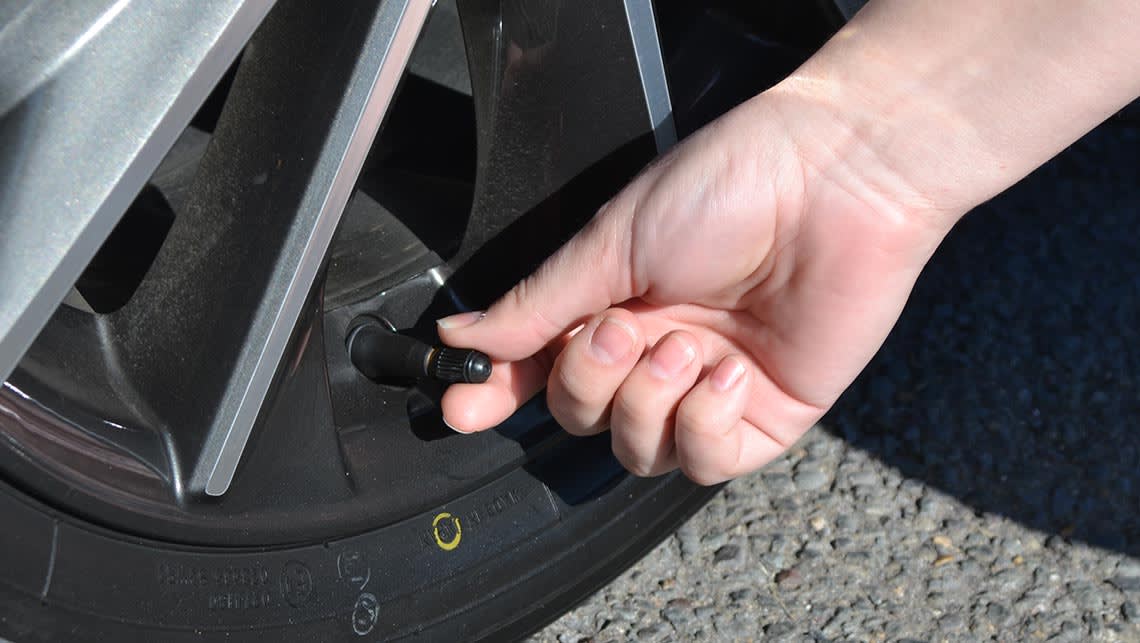
A Presta valve is found on road bikes and some mountain bikes. It’s a slender valve with a nut at the top that is loosened and tightened before and after inflation. Almost all new bike pumps have a head with openings for both Schrader and Presta valves, or they have an adapter for switching from Schrader to Presta, like one of our top picks, the Topeak – Road Morph G.
If you’re out riding and your tires need air, you could give them a quick inflate with a CO2 injector, like the one we reviewed. But if you don’t have a CO2 injector in your bag, and you forgot your mini pump, then you can pull into a gas station and inflate your tires there.
If you don’t have a pressure gauge, ask the station attendant for one. Inflate your tires to optimal pressure in short bursts; a gas-station air pump has very high pressure, and you run the risk of popping your tire.
A gas-station air pump will only fit a Schrader valve. But if your tires have Presta valves and you don’t have a Presta valve adapter, there’s still a way to inflate them.
Share this Review
Gene Gerrard, Writer
Gene has written about a wide variety of topics for too many years to count.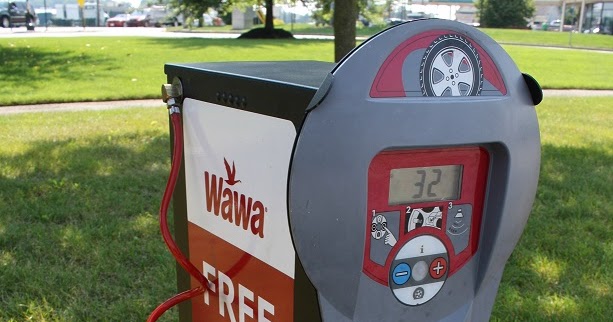 He's been a professional chef, cooking-appliance demonstrator, playwright, director, editor of accountancy and bank-rating books, Houdini expert and dog lover (still is). When he's not writing for Your Best Digs, he's performing as a magician at the Magic Castle in Hollywood.
He's been a professional chef, cooking-appliance demonstrator, playwright, director, editor of accountancy and bank-rating books, Houdini expert and dog lover (still is). When he's not writing for Your Best Digs, he's performing as a magician at the Magic Castle in Hollywood.
I’ve often cycled past gas stations and wondered whether it would be possible to fill up my bike tires using the air compressors that you see on every forecourt. So I decided to do some research to see if it could be done.
The quick answer? Yes. But it comes with a large health warning attached. Why? Well, those air compressors aren’t regulated in the same way (or at all, in fact) like gas pumps are. So, unlike with gasoline, when you pump air using one of those compressors you can never be entirely sure how much air you’re going to get with each pull of the trigger. That’s fine if you’ve got a big car tire to inflate, but when you’ve got a more delicate bicycle inner tube then it can be very easy to pop it. If you’ve ever popped an inner tube through over-inflation you’ll know that it can give you quite a shock, both from the initial bang and then the lengthy walk home pushing your bike with the flat tire.
If you’ve ever popped an inner tube through over-inflation you’ll know that it can give you quite a shock, both from the initial bang and then the lengthy walk home pushing your bike with the flat tire.
So, if you are stuck away from home with a deflated tire and your only option is to use a gas station pump, then first check that the attendant is happy for you to use it, and second, proceed with extreme caution. Remember that an under-filled tire is always better than a popped tire.
We’ll take a look at the methods of inflating tires with Schrader and Presta valves in a moment. We’ll then look at a couple of far superior options to ensure that you never have to risk using a gas station pump.
A better alternative to a gas station pump is the Lezyne Twin Kit CO2 Inflator. This ultra-compact tire inflator fits both Presta and Schrader valves, is super-simple to use and will get you back on the road FAST!
Image | Check prices | |
1. | View product | |
2. Brass Presta Valve Adapter | View product | |
2. Topeak Road Morph Pump with Gauge | View product |
First up, you need to determine what type of valve your bike tires have. The valve is the metal tube that pokes through the wheel rim towards the center of the wheel. There are two main types: Schrader and Presta. Schrader valves are the same type as you get on car tires. Presta valves are longer and thinner and have a locking nut towards the tip. You’ll often see Schrader valves on mountain bikes and Presta valves on road bikes.
The valve is the metal tube that pokes through the wheel rim towards the center of the wheel. There are two main types: Schrader and Presta. Schrader valves are the same type as you get on car tires. Presta valves are longer and thinner and have a locking nut towards the tip. You’ll often see Schrader valves on mountain bikes and Presta valves on road bikes.
If you have Schrader valves then it is a much simpler process to inflate your tires using a gas station pump as the nozzle of the air hose will fit your bike tires:
Gas station air hoses are all designed to fit on to Schrader valves as this is what car tires have. If you have Presta valves on your bike tires you will need to use an adapter to sit between the air nozzle and the valve to give an airtight seal.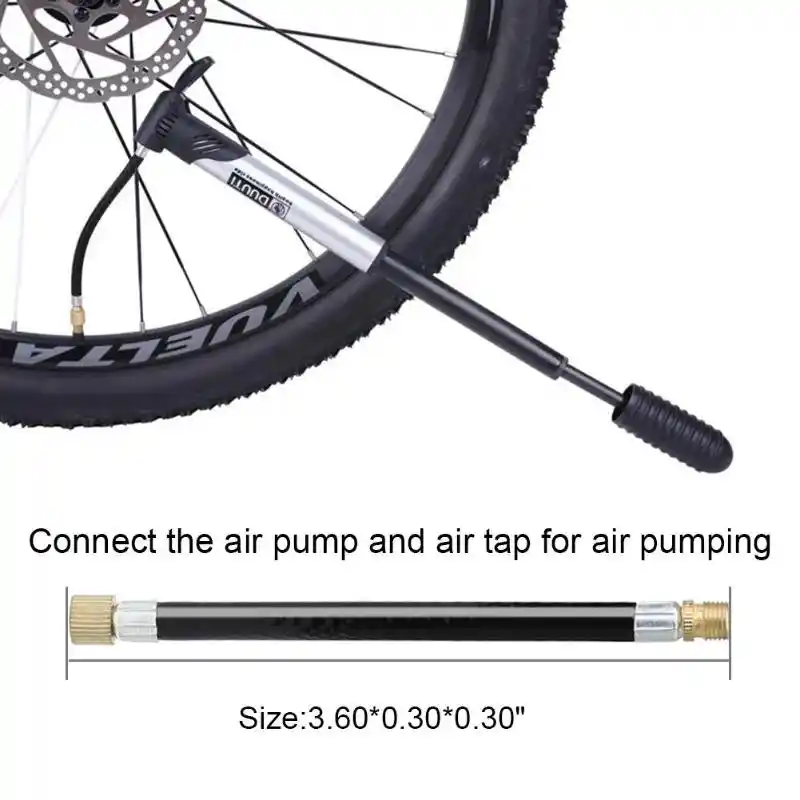 These adapters are not expensive, however, you will need to purchase one in advance as they are unlikely to be available for sale at the gas station when you need it.
These adapters are not expensive, however, you will need to purchase one in advance as they are unlikely to be available for sale at the gas station when you need it.
Buy one of these Presta valve adapters now.
Then keep it safe and ready to use, in one of your jersey pockets or tucked inside your bike saddlebag.
View Details on Amazon
How to inflate Presta valve with adapterThese adapters are very easy to use. Just unscrew the dust cap, loosen the Presta valve locking nut and screw the adapter on over the tip of the valve. You’re then ready to connect the air hose nozzle and (very carefully) inflate your tire. When you’re done, remove the adapter (putting it back in its safe place), tighten the valve locking nut, and screw the dust cap back on.
We’ve seen that, with care, you can use gas station air pumps to inflate your bicycle tires. The trouble is that sometimes gas stations are few and far between. If you can’t rely on having a handy gas station when you need to inflate your tires, what should you do?
The simple answer is to take a pump with you. There are lots of different bike pumps available and many are very small and powerful. We’ll take a look at two of my favorite options now. One requires some manual labor. One uses the magic of an air compressor packed into a tiny travel size. Let’s take a look.
There are lots of different bike pumps available and many are very small and powerful. We’ll take a look at two of my favorite options now. One requires some manual labor. One uses the magic of an air compressor packed into a tiny travel size. Let’s take a look.
Topeak Road Morph Pump with Gauge
Back in the day, bike pumps used to be huge things that never seemed to blow out more than an asthmatic puff of air at a time. Thankfully those days are gone and we have fantastic bike pumps like this one.
It fits onto your bike frame with the included mounting system, so you’ll never forget to take it out with you. When you need it, it works with both Presta and Schrader valves and can inflate tires up to 140 PSI. Yes, that will take some work, and you’ll probably need a Coffee ‘n’ Cake stop shortly after to recover, but then you’ll be back on the road. One clever feature of the pump is its fold-out foot and handgrip – these make it comfortable and stable to use.
View Details on REI
Lezyne Twin Kit CO2 Inflator
This is my absolute favorite piece of bike kit (possibly more than the bike itself…) This pump uses compressed cartridges of CO2 (it comes with 2 cartridges, so you’re good to go). These are used to blow air through the nozzle into your tires. One cartridge will inflate 1-2 tires fully, so I tend to take two cartridges and the nozzle when I go out on the bike. The kit is so tiny that you’ll forget you’ve got it with you (until you need it) and it won’t interfere with the snack-carrying capacity of your jersey pockets.
The air nozzle is easy to use and works with both Presta and Schrader style valves and replacement cartridges are easy and cheap to source online. Before I got one of these I wondered how good they would actually be. Earlier this year as I was inflating a tire in the middle of a mud bath in the midge-infested Scottish Highlands, I congratulated myself again for buying one of these. Inflation took a few seconds, there was no tiresome pumping, and I was away again pedaling to escape the flying beasties.
Inflation took a few seconds, there was no tiresome pumping, and I was away again pedaling to escape the flying beasties.
View Details
So, we’ve seen that, yes, it’s possible to pump up bike tires using a gas station air pump. I wouldn’t advise it though, because of the risks, so use it only as a last resort.
If you’ve got Schrader valves, then you’re good to go as these are the same valves as car tires have. If you’ve got Presta valves then you will need to buy an adapter beforehand.
There are better alternatives to gas station air pumps though. Ones that you can use on the many miles of road where there isn’t a gas station to be found for miles. These are designed to be used on bike tires so are safer to use.
If you’d like more detail on the difference between Schrader and Presta valves and a look at how the Presta adapters fit, then check out this video:
Happy cycling!
**Please note that our reviews are based on customer reviews, star ratings, and online complaints. Therefore, Bicycle Volt are in no way liable**
Therefore, Bicycle Volt are in no way liable**
Contents
Flat tires do not bode well for the cyclist. The situation must be resolved immediately, otherwise you will have to become a pedestrian for a while. What should be done? That's right, pump up the camera and calmly continue moving. Consider how to pump up a bicycle wheel with a pump, what subtleties are available when using an autocompressor, and whether it is possible to do without a pump.
Tire pressure is the main parameter that is responsible for the speed of movement, grip and safety of the cyclist. The average minimum indicator for bicycles is 2 atmospheres. For driving on asphalt, the recommended value is within 3.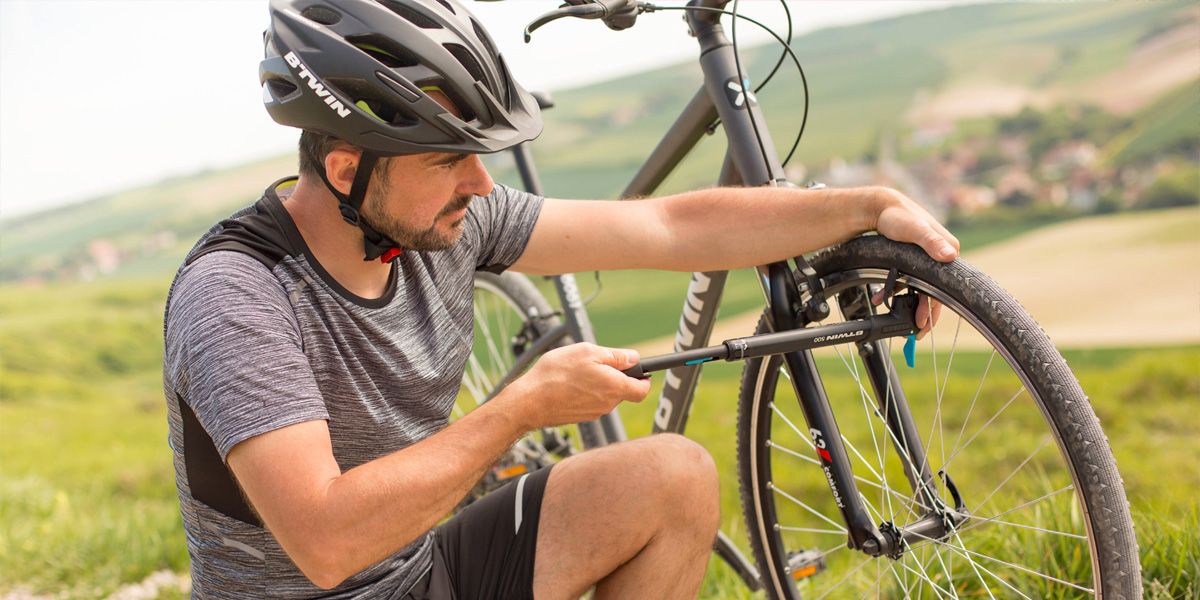 5 atm., For primers - 2.6 - 2.8 atm.
5 atm., For primers - 2.6 - 2.8 atm.
It is easy and simple to determine the pressure inside the bicycle tube using a pressure gauge - separate or built into the pump:
Another method: feel around the entire circumference of the tire with your fingers. If the rubber does not flex, then you can ride. It should be noted that this method will only give accurate results for thin slicks on road bikes and tires on city bikes.
Consequences of underinflated tyres:
On the contrary, an excess amount of air in the chambers threatens the following:

Maintaining the recommended pressure will eliminate all these shortcomings and allow you to get the most out of your trips. Below is a table of values depending on the weight of the cyclist:
| The mass of the cyclist, kg | atmospheres/PSI* |
| 50 | - 2.59/35 - 38 |
| 3.1/45.5 | |
| 90 | 3.6/53 |
| 105 | 3.9/57.5 |
| 4.1/60 | |
| 118 | 3.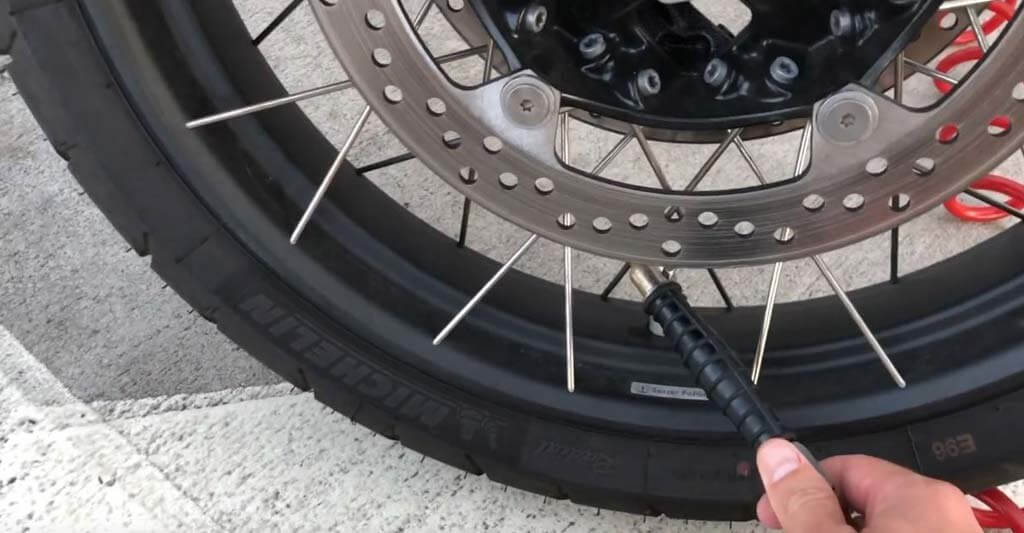 2 - 3.4/47 - 50 2 - 3.4/47 - 50 |
*1 atm = 14.696 Psi
In general, a bicycle pump is a necessary thing for every cyclist. With the help of this simple device, it will be possible to inflate the wheels on your own, and not roll your bike to a service or gas station.
Hand pumps are divided into two types: simple and with a recording device (pressure gauge). It is recommended to purchase the second option, however, if a separate pressure gauge was lying around in the cabinet, you can buy a cheaper pump.
Universal hand pump with dial gauge
For ease of pumping with a conventional hand pump, you can immediately count the number of air inlets until the optimum pressure is reached and then pump exactly like this, even without additional use of a pressure gauge.
How to inflate the chambers correctly:
 You can also inflate on an upside down bike or the wheel separately if the bike is being dismantled.
You can also inflate on an upside down bike or the wheel separately if the bike is being dismantled. Pressure tracking:
By the way, the latter will not be superfluous to do with a pressure gauge, since the pressure inside the pump can increase during pumping, but air does not enter the chamber (the valve is not completely closed) or exit through a hole in it.
Common bicycle nipples are automotive and Dunlop. For thin wheels, a Presta nipple with a valve is used. It requires cleanliness and accuracy in handling.
Presta tubes fitted to road bikes and select hybrids
A special small volume pump is matched to it.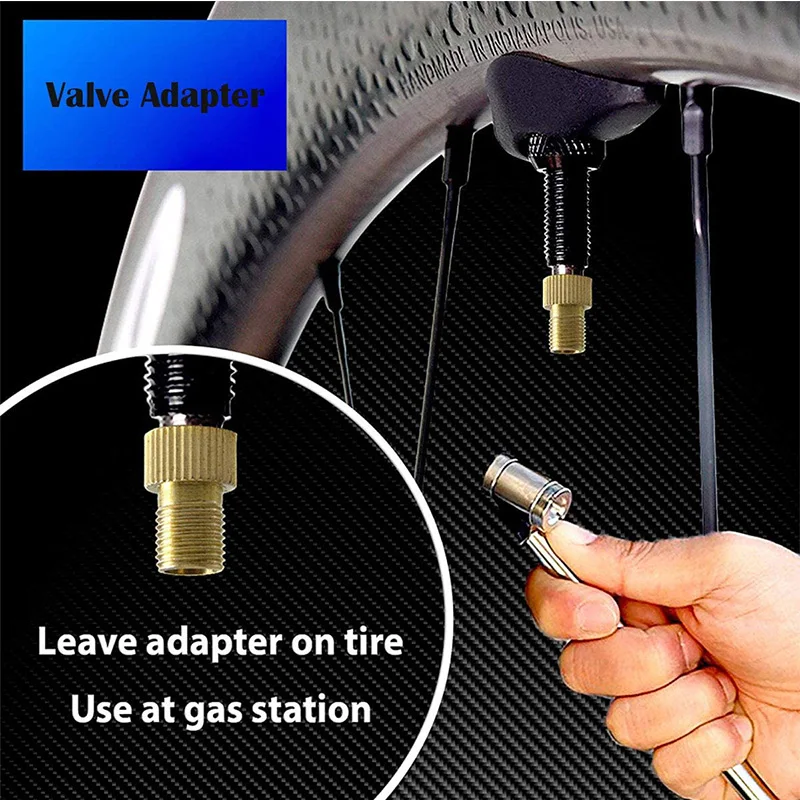 A regular bike pump may not fit or you may need to use an adapter.
A regular bike pump may not fit or you may need to use an adapter.
Most bicycles have a "Schrader" or car valve. The standard option allows you to inflate tires at gas stations and public bike pumps (of which there are only a few in our cities so far) directly.
How to inflate simple wheels with a car pump:
How to inflate your Presta with a compressor at a gas station:

In this case, it is very important to know exactly how many atmospheres it is necessary to let air into the chambers. With increasing pressure, it can quickly burst.
The last option left is Dunlop. It is identical in size to an automobile nipple, but in terms of design features it is similar to the French one (aka Presta). When inflating a wheel, you should follow the rules for a sports analogue.
Is it possible to inflate bicycle inner tubes without a pump? It is unlikely to reach the recommended pressure, since a regular supply of pressurized air is required, but you can reach the minimum values. Let's consider several methods of pumping chambers, which can be resorted to without using a pump:
Vacuum cleaner. Many models are equipped with a blower mode, when switched to which air is blown out. A thin hose can be used to connect the wheel nipple. The result directly depends on the tightness of the connection between the hose and the nipple. Here you can use rubber pads, clamps and even rags.
A thin hose can be used to connect the wheel nipple. The result directly depends on the tightness of the connection between the hose and the nipple. Here you can use rubber pads, clamps and even rags.
Bottle pump. You will need two plastic bottles. One of them will serve as a cylinder, the other as a rod. Cut off the bottom of the first bottle and connect its neck through a thin hose to the chamber outlet. Next, insert the second bottle into it and with translational movements pump air through the cylinder into the hose. For tightness, grease the connection of the neck and the hose with sealant or lay a rubber pad. High pressure cannot be created, but it is possible to ride the N-th distance on a bicycle.
Bottle pump schematic: 1 - "rod", 2 - cylinder, 3 - cylinder neck, 4 - hose
The third way is to remove the nipple and inflate like a balloon. The method is fraught with difficulties in its removal and installation in its rightful place. It will be especially difficult to install back, since during this time all the air can be released.
It will be especially difficult to install back, since during this time all the air can be released.
An alternative tire inflation option is to inflate with a bicycle air fork pump. You will have to work hard, as this pump is designed for small volumes.
Despite the fact that a resourceful person will find a way out of any situation, it is recommended to have a special pump for tire inflation. Moderately inflated bicycle chambers are the key to comfortable trips without unpleasant surprises in the form of a burst chamber or damage to the wheels.
CONTENT OF THE ARTICLE:
No special effort is required to properly inflate bicycle tires. The only thing you need is the right tools. Using these techniques, you can easily find your valve type and choose the pump that is exactly right for your bike model, respectively, and learn how to properly inflate your tires.
The only thing you need is the right tools. Using these techniques, you can easily find your valve type and choose the pump that is exactly right for your bike model, respectively, and learn how to properly inflate your tires.
Related: How to choose a bicycle pump?
1. Schrader valve, sometimes you can see the name American valve or automobile valve. The stem in this type of valve is surrounded by threads, you just need to press down on the stem with your thumbnail or other object, such as a pen cap. If we compare Schrader valves with other types, then it is short and wide in diameter. Most often they can be found on cars, inexpensive or mountain bikes. To open this type of valve, you just need to unscrew the rubber plug.
2. Determine the recommended tire pressure for your bike. Often this indicator is located on the sidewall of the tire. Be vigilant and watch the pressure when you inflate your tires. It is recommended not to bring the readings to the lower line, as well as to the highest.
It is recommended not to bring the readings to the lower line, as well as to the highest.
3. Position the pump. If you don't already have your own, use the pump at the gas station, or borrow one from a friend.
4. Pump up the chamber. To do this, unscrew the rubber cap on the top of the valve and hide somewhere so as not to lose it.
5. To deflate a tire with a Schrader valve, simply press the springy valve stem with your fingernail or other small object until all air is expelled.
1. French valve (Presta) or else you may see the name Sclaverand is commonly found on high performance road bikes. Compared to a Schrader valve, this one is longer and narrower in diameter, and has an outer stem that is capped instead of being surrounded by a core.
French valve (Presta) or else you may see the name Sclaverand is commonly found on high performance road bikes. Compared to a Schrader valve, this one is longer and narrower in diameter, and has an outer stem that is capped instead of being surrounded by a core.
2. Valve opening. Unscrew the dust cap to open the Presta valve. Then you need to loosen the brass cap on the valve stem a little, it will not be able to come out completely, and you will have to lift it up a little. If you want to check if the cap is loose, you just need to press on the valve stem, and if you hear that the air comes out in sharp gusts, then this is a sign that you can stop.
3. Calculate the recommended tire pressure for the bike. This is usually a relief mark that is located on the sidewall of the tire. Most often, these readings are written in bars or PSI. Do not let the pressure go to the bottom line, and also to the highest, which exceeds the maximum.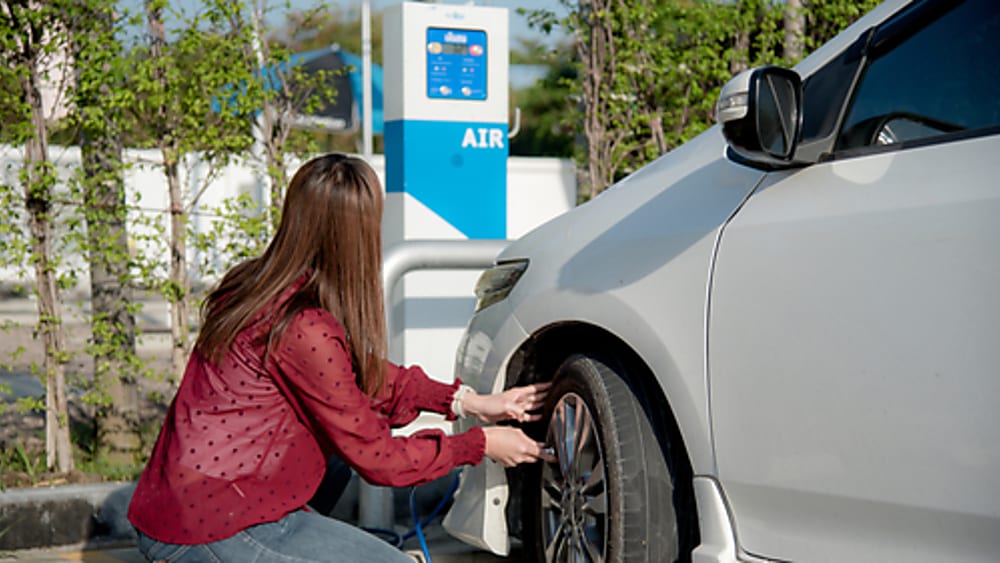
4. Pump installation. You can use the pumps of any gas station stations or take them from friends. And as an option - buy in the store "everything for bicycles".
5. Inflate tires. Open the Presta valve by unscrewing the dust cap and loosening the smaller brass cap.
6. To deflate a tire with a Presta valve, open the brass cap and press the springy valve stem until all air is expelled.
The third type of valve is the English Woods valve, or the name Dunlo is also found.